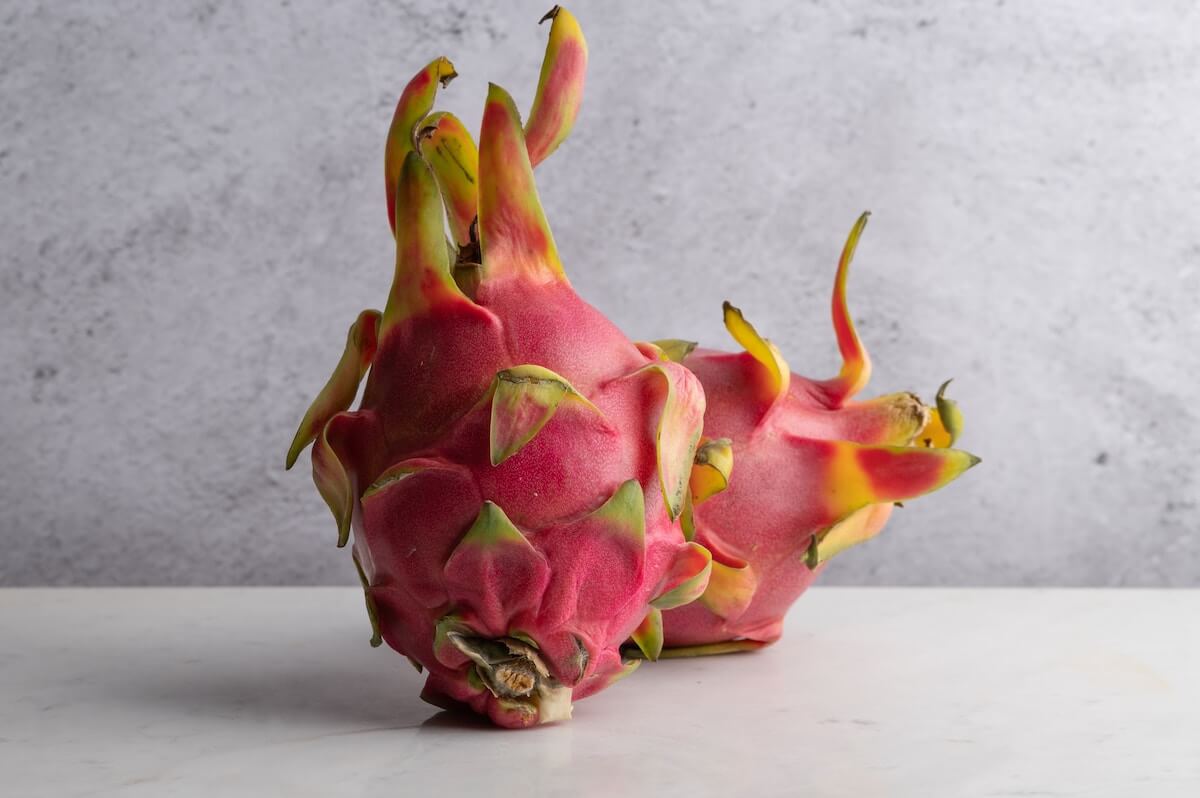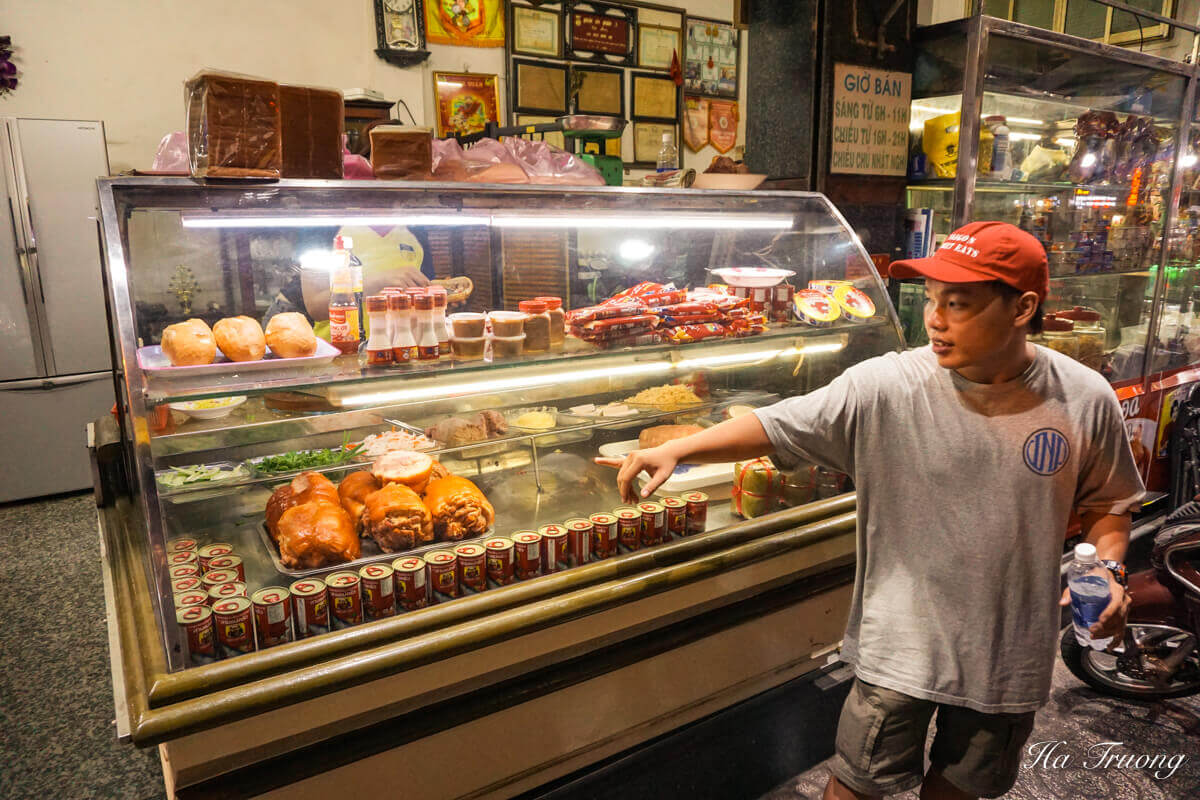Vietnamese Fruits Guide: 15 Delicious Fruits To Try
Vietnam is a tropical paradise that boasts a rich variety of fruits, each with its own distinct flavors, textures, and aromas. From the vibrant colors of dragon fruit to the juicy taste of mangosteen, Vietnamese fruits are a true delight for the senses.
As a local, I have an unwavering love for Vietnamese fruits. At home, we take our fruit game seriously. We always make sure to have a colorful assortment of at least three different types of fruits readily available. It’s like having a fruity paradise right in our kitchen!
In this travel guide, I’d love to share with you some of my favorite Vietnamese fruits.
Jackfruit (Mít)
Imagine walking through a bustling Vietnamese market and spotting a massive, green, spiky fruit. That’s jackfruit!
Weighing up to a whopping 23 kg (55 pounds), it’s hard not to be in awe of jackfruit’s sheer size.
But don’t let its intimidating exterior deter you—inside lies a treasure trove of golden, fibrous flesh that is an absolute delight for the taste buds.

One of the things I love most about jackfruit is its versatility. It has a sweet and tropical flavor that resembles a combination of pineapple, banana, and mango.
The flesh has a distinct texture, with some parts being soft and juicy while others have a firmer, meat-like consistency. This unique texture makes jackfruit a fantastic ingredient in both savory and sweet dishes.
I usually enjoy the Jackfruit by itself, but you can find also it in savory dishes such as stews, curries, and stir-fries. Its meaty texture makes it a great substitute for meat, and it absorbs flavors beautifully.
Jackfruit also shines in desserts and snacks. From jackfruit smoothies and ice cream to dry jackfruit and jackfruit-filled pastries, there’s no shortage of creative ways to indulge in this tropical delight.
Dragon Fruit (Thanh Long)
Dragon fruit, or “Thanh Long” as we call it in Vietnam, is another delicious fruit to try on your Vietnam trip.
Whether it’s a dragon fruit smoothie on a hot day in Ho Chi Minh City or a dragon fruit-infused dessert in Hoi An, each experience is nothing short of delightful.

Its eye-catching red skin, adorned with speckles, is a feast for the eyes. When you slice open dragon fruit, you’ll be greeted by a subtly sweet flavor and a satisfying crunch that refreshes your taste buds.

One interesting fact about dragon fruit is its origin. While it’s commonly associated with Southeast Asia, it actually originates from America. The fruit has made its way across the globe, and we’re lucky to have it as a beloved part of our Vietnamese culinary heritage.
In Vietnam, you can find dragon fruit in local markets, fruit stalls, and even as an ingredient in street vendors’ beverages. I recommend buying the one with speckled red flesh instead of white flesh because it tastes sweeter.
Mangosteen (Măng Cụt)
Mangosteen, also known as “Măng Cụt” in Vietnamese, is a fruit that captivates both the eyes and taste buds. This small, round fruit is characterized by its deep purple rind, which is firm and glossy.

It is rich in antioxidants, vitamins, and minerals, making it a nutritious choice for those seeking a wholesome snack.
In Vietnamese culture, mangosteen is often considered a cooling fruit that helps balance the body’s temperature during the hot summer months.
To enjoy mangosteen, simply peel away the thick rind and savor the juicy segments. Inside, you’ll find a treasure trove of sweet, juicy segments nestled in a white, cottony membrane. Each segment is like a little burst of flavor, delicately balancing sweetness and tanginess.
Rambutan (Chôm Chôm)
Rambutan is a Vietnamese fruit that not only looks intriguing but is also delicious.
Imagine holding a small, round fruit with a hairy exterior resembling a sea urchin. That’s rambutan for you! Now, don’t let the spiky appearance intimidate you.

Once you peel away the skin, you’ll reveal a juicy, translucent flesh that’s simply mouthwatering.
The first bite of rambutan is always a lovely surprise. The juicy flesh has a mildly sweet and slightly acidic taste that instantly refreshes your palate.
Here’s a tip: To fully enjoy rambutan, gently squeeze the fruit, and the flesh will pop out of the skin. Pop it in your mouth, and savor the juicy explosion of flavors. It’s such a satisfying treat, especially on a hot summer day.
Longan (Nhãn)
If you happen to visit Vietnam during the longan season, which typically falls between July and September, you’ll find this tropical gem abundantly available in local markets and street stalls.
Longan is a small, round fruit with thin, brown skin that might not catch your eye at first, but don’t let that fool you.
Once you peel away the skin, you’ll be greeted by a translucent fruit that’s bursting with a floral sweetness. The juicy flesh is so refreshing and addictive that it’s hard to stop at just one.

To fully enjoy longan, gently squeeze the fruit until the skin cracks, and then peel it away. Inside, you’ll find juicy, pearl-like fruits that are perfect for popping into your mouth.
It’s a great snack to satisfy your sweet cravings, and it’s also a fantastic addition to fruit salads and desserts.
Durian (Sầu Riêng)
If you’re feeling adventurous, try Durian! It’s often referred to as the “King of Fruits” due to its distinctive characteristics and strong aroma.
Let’s address the elephant in the room: the smell. Durian has a distinct aroma that some find overpowering. People often describe it as a mix of sweet, ripe fruit and a pungent note.

Trust me, the smell might catch you off guard at first, but don’t let that scare you away. It’s all part of the durian experience.
Once you get past the initial whiff, you’ll be rewarded with a flavor experience like no other. It’s an explosion of creaminess and richness that you won’t find in any other fruit.
Some even describe it as a combination of caramel, almond, and hints of garlic. Yes, it’s that complex!
If you want to try durian, head to local markets or fruit stalls in Vietnam, especially during the peak season from June to August. Whether you love it or hate it, trying durian is an experience that will leave an impression.
Star Apple (Vú Sữa)
Imagine sinking your teeth into a creamy, custard-like flesh that melts in your mouth, releasing subtle sweetness and a milky flavor. It’s Star Apple (Vú Sữa), one of my favorite Vietnamese fruits.
This fruit gets its name from the star-shaped pattern that appears when you cut it crosswise.
The best time to find this delectable fruit is during its peak season from August to October. The skin of the fruits is green or purple, but I prefer the green version.

To enjoy a Star Apple, simply cut it open and scoop out the luscious flesh with a spoon.
You should be cautious of the milky sap found in the skin and near the seeds. It can be slightly sticky and may stain your clothes, so it’s best to handle the fruit with care and paper tissue.
Sapodilla (Hồng Xiêm)
When you hold a Sapodilla in your hands, you’ll notice its brown skin that hides a world of flavor within.
This fruit is typically available from late summer to early winter, so make sure to plan your visit accordingly.

As you take your first bite, you’ll be greeted by a rich, caramel-like sweetness that dances on your tongue. The flesh has a grainy texture reminiscent of a pear, and its unique flavor is like a beautiful blend of brown sugar and honey.
You can also see it in various Vietnamese desserts. Its creamy texture and sweet flavor make it a perfect addition to ice creams, smoothies, and even baked goods.
Grapefruit (Bưởi)
Its vibrant appearance and enticing aroma make grapefruit a standout fruit in the citrus family.
When you slice open a grapefruit, you’ll be greeted by juicy segments that are packed with a refreshing, sweet-sour taste.

I like eating fresh grapefruit with a chili salt mixture (muối ớt). You can also add its segments to salads for a refreshing twist, or use the juice in dressings and marinades to enhance the flavors. And let’s not forget the tasty grapefruit juice and smoothies.

Custard Apple (Mãng Cầu)
Custard apple is typically available during the warmer months in Vietnam, from late summer to early autumn.
When you come across a custard apple, you’ll immediately notice its distinctive appearance. It has a knobby green skin that hides a delectable secret inside.

As you slice open the fruit, a sweet, fragrant aroma fills the air, inviting you to taste its creamy, custard-like flesh. The texture is smooth, and the flavor is a great blend of sweetness and hints of vanilla.
While you can enjoy custard apple on its own, it’s also a fantastic addition to desserts and smoothies. You can blend the flesh or add it to ice creams and milkshakes for a tropical twist.
Guava (Ổi)
Guava, or “Ổi” in Vietnamese, is a delightful tropical fruit that never fails to capture our taste buds with its unique flavor and fragrance.
The guava’s vibrant green skin hides a world of deliciousness within. Inside, you’ll see its pink or white flesh, filled with tiny edible seeds that add a delightful crunch.

I personally don’t like the seeds much, but some Vietnamese also eat them.
Whether you enjoy it raw, blend it into a smoothie, or juice, guava never fails to impress. The taste of guava is a perfect balance between sweet and tangy, with a hint of tropical goodness.
To get sweeter guava, pick the one that feels soft. The riper it is, the sweet it gets. I especially love red guava (ổi ruby), with its striking red color.
Once ripe, red guava fills the air with its irresistible sweet and fragrant aroma, enticing your senses and beckoning you to indulge in its juicy deliciousness.
Watermelon (Dưa Hấu)
Watermelon, or “Dưa Hấu” as we lovingly call it in Vietnam, is a must-try fruit that embodies the tropical essence.
Whether enjoyed as a refreshing snack, added to fruit salads, or blended into smoothies, every encounter with this fruit is a delicious experience.

With its vibrant green rind and ruby-red flesh, watermelon is a visual feast that instantly whets your appetite. As you take a bite, you’ll be greeted by its explosion of sweet, juicy flavor that cools you down and quenches your thirst.
In Vietnam, you can buy watermelon in local markets, street vendors, and even small roadside stalls. You’ll often see vendors expertly slicing open watermelons, ready to be enjoyed on the spot or taken home for a refreshing treat.
Lychee (Vải)
If you visit Vietnam in the summer, don’t miss out on trying lychee, a juicy fruit often planted in northern regions of Vietnam.
An interesting note is that lychees used to be a tribute to the king, but now everyone can enjoy them. You can often find lychee in bustling markets, and street stalls, and even as a refreshing ingredient in drinks and desserts.

With its rough, textured skin in shades of red and pink, lychee is a visual treat that beckons you to indulge.
Once you peel away the skin, you’ll discover translucent and sweet flesh. I highly recommend trying lychee in its fresh form, savoring each juicy bite!
Mango (Xoài)
In Vietnam, mangoes are a beloved fruit and are used in a variety of dishes and desserts.
During hot weather, there’s nothing more refreshing than enjoying a bowl of freshly cut mangoes or indulging in mango smoothies.
If you plan to buy mangoes at local markets or street vendors, look for the varieties such as “Xoài cát” and “Xoài ngọt,” known for their sweet taste and juiciness.

You may also see locals eating green mango. These unripe mangoes have a tangy and sour taste. Often accompanied with chili salt, the firm and crunchy texture of green mango offers a satisfying bite.
Banana (Chuối)
In Vietnam, bananas are a staple fruit that you can find in almost every corner. From the popular “Chuối sứ” variety with its slightly tangy flavor to the smaller “Chuối cau” that packs a sweeter punch, there’s a banana for every preference.
You can enjoy bananas in many ways – a quick and nutritious snack, smoothies, or ingredients of delicious bread and cakes.
You can also find the local favorite grilled banana wrapped in sticky rice (Chuối nếp nướng). The possibilities are endless!





